Is there life on Mars? Sojourner, Spirit, Opportunity and Curiosity go roving
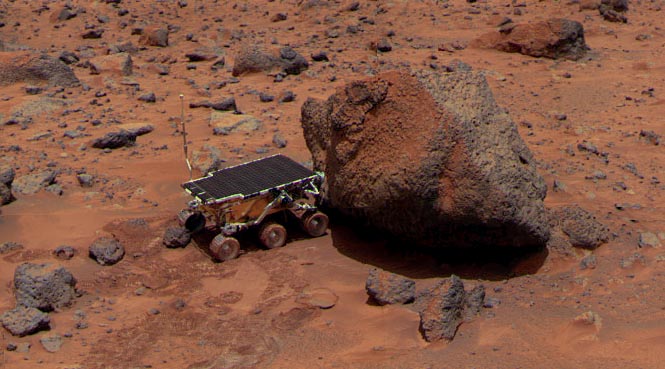
The NASA rover Curiosity is expected to be landing on Mars at 3:31 am August 6, 2012 (AEST). It’s mission, lasting one Martian-year (98 Earth weeks), is of scientific significance and perhaps even of human significance. Curiosity will be fulfilling the prospecting stage of a step-by-step program of exploration, reconnaissance, prospecting and mining evidence for a definitive answer to the question “Has life existed on Mars?” In answering this question scientists will also be determining the habitability of Mars for humans.
Is there life on Mars?
Life as we know it depends on liquid water.
Life began appearing on Earth within a billion years of its formation. The oldest probable traces of life dating back to within 700 million years of its formation. This is not long after the end of a period where the crust of the newly formed Earth was kept molten by heavy bombardment from asteroid or comets. Mars enjoyed similar conditions for a few hundred million years during its Noachian period.
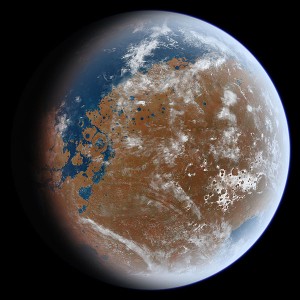
Water on Mars now is much less abundant than it is on Earth, at least as a liquid or gas. Most of the water known is locked into the permafrost and polar caps, Only a small amount of water vapor is present in the atmosphere.Vast quantities of water have been discovered frozen beneath much of the Martian surface.
There are however no bodies of liquid water creating surface lakes oceans and certainly no canals!
We have come to understand that Mars had enough water to form lakes and to carve huge river valleys. There was still abundant water on Mars in the form of catastrophic flooding through its Hesperian period.
Nevertheless, many significant issues remain. When exactly was the water once flowing on Mars? Was water persisting for long enough for life to develop and evolve? Are there special environments that could be supporting life? Could life have adapted for high salt, high acid conditions? Could life on Mars stay viable for millions of years when conditions turned hostile for life as we know it?
Getting to Mars can be a tough challenge
Curiosity will be the fourth rover and be the most advanced scientific laboratory to go exploring our neighbor, the red planet, Mars. The rovers, representing a formidable pedigree of success by the USA space agency NASA, vary from the 1997 microwave oven size Sojourner, the magnificently resilient twins Spirit and Opportunity of 2003, to the 2012 sophistication of Curiosity.
Recent proposals of human exploratory missions to Mars seemingly gloss over the difficulty in landing safely on Mars. Mars has proved to be a tough target to explore directly. Failures to date are numerous and come from the USSR/Russia, USA and British space agencies. Whilst the USSR/Russians, USA, Chinese and Japanese have all suffered failures of, what appears to be the more simple objective of safely orbiting Mars.
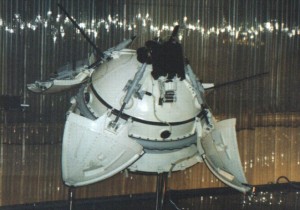
The first probe to make a ‘soft-landing’ on Mars was the USSR’s Mars 3 on December 3, 1971. Unfortunately it stopped operating, 20 seconds after landing. This was a second blow to the Martian aspirations of the USSR who on November 2 of the same year lost their identical probe Mars 2, this one entering at too steep an angle and burning up in the thin Martian atmosphere.
The early explorers
The NASA Viking probes were the first to successfully land on Mars; Viking 1 on July 20, 1976 and Viking 2 on September 3, 1976. These were both stationary probes, exploration was limited to there landing site. The first rover was the Sojourner, which powered its way into history on late July 4, 1997. Landing in the Martian night, daylight bought power to its solar cells, and within hours of landing, the Pathfinder lander had unfolded, and began transmitting data and pictures. The next day it’s 10.6kg robotic Sojourner began roving.
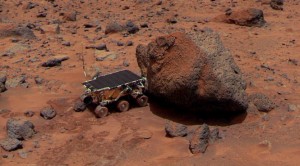
Roving conjures an image of long voyages and far-flung lands. Well Mars is far away. Sojourner was a cautious and leisurely rover with a maximum speed of one centimetre per second (0.036km/hour) and travelling approximately 100 metres in total, and never wandering more than 12 metres from Pathfinder. During its 83 sols (a mean Martian solar day, or “sol“, is 24 hours, 39 minutes, and 35.244 seconds long) of roving, it sent 550 photographs to Earth and analyzed the chemical properties of 16 locations near Pathfinder.
Sojourner didn’t find evidence of life. However its data was sufficiently sensitive to enable scientists back on Earth to identify the types of rocks it encountered – mission accomplished.
The Pathfinder lander also was actively photographing and measuring, sending 16,500 pictures and making 8.5 million measurements of the atmospheric pressure, temperature and wind speed. By taking multiple images of the sky at different distances from the sun, Pathfinder images enabled scientists to determine that the size of the particles in the pink Martian haze was about one micrometre in radius. Furthermore the color of some soils was similar to that of an iron oxyhydroxide phase which would support the theory of a warmer and wetter climate in the past.
In addition to scientific objectives, Mars Pathfinder was designed to be a “proof-of-concept” for the technology necessary to deliver a lander and a free-ranging robotic rover to the surface of Mars in a cost-effective and efficient manner. This mission Successfully trialling various technologies, such as airbag-mediated touchdown and automated obstacle avoidance, this mission paved the way for both Spirit and Opportunity.

Mars Pathfinder also fulfilled its political goals. It was remarkable for its extremely low cost, relative to other unmanned space missions to Mars. Its total mission cost was US$280million. This was including the launch vehicle and mission costs and a blisteringly short 3 year US$150million development cycle. For comparison the Viking mission cost US$935 million in 1974- or US$3.5 billion in 1997-money.
Remote observation
Mars is currently host to three functional orbiting spacecraft: NASA’s Mars Odyssey and the Mars Reconnaissance Orbiter, and the ESA’s Mars Express. The 2001 Mars Odyssey, to give it its full name, arrived in orbit around Mars on October 24, 2001. The name was selected as a tribute to the “vision and spirit of space exploration as embodied in the works of renowned science fiction author Arthur C. Clarke.” After spending three years mapping the amount and distribution of many chemical elements and minerals that make up the martian surface. Including the distribution of hydrogen which led scientists to discover vast amounts of water ice in the polar regions buried just beneath the surface. Mars Odyssey also recorded the radiation environment in low Mars orbit to determine the radiation-related risk to any future human explorers who may one day go to Mars. It has since acted as an orbiting communication relay for the NASA surface lander and rovers.
The over-achieving twins
Remote sensing from orbit is one thing. There is nothing more convincing than a hands-on experiment, or the next best thing a robotic experimenter. The ability to use rovers to qualify and quantify the remote observations has proved invaluable for our understanding of the planet Mars. Scientists can also use these experiences to extrapolate on the remote observations of other planets in our solar system and perhaps even the growing catalogue of exoplanets.

NASA’s twin robot geologists, the Mars Exploration Rovers, Spirit and Opportunity, launched toward Mars on June 10 and July 7, 2003. The mission’s scientific objective was to search for and characterize a wide range of rocks and regoliths that hold clues to past water activity on Mars.
On March 23, 2004, a news conference was held announcing “major discoveries” of evidence of past liquid water on the Martian surface. A delegation of scientists showed pictures and data revealing a stratified pattern and cross bedding in the rocks of the outcrop inside a crater in Meridiani Planum, landing site of Opportunity. This suggested that water once flowed in the region. The irregular distribution of chlorine and bromine also suggests that the place was once the shoreline of a salty sea, now evaporated.
Further graphic example is shown in the images of a thin fin on the edge of a rock in “Victoria Crater”, taken by Opportunity. The fin was rich in hematite, a mineral that often forms in the presence of water. Long ago, water circulating through a crack in the sandstone may have dissolved some of the surrounding material and filled the crack with mineral deposits. The filling resisted weathering while the surrounding rock eroded away. Today, the fin marks a place that used to be empty, and the space around it used to be rock!
In recognition of the vast amount of scientific information amassed by both rovers, two asteroids have been named in their honor: 39381 Spirit and 39382 Opportunity.
Postcard from a winter holiday
Does life exist on Mars now? Has life existed at any stage in the past? These questions are unanswered at present. A successful mission by Curiosity will certainly bring an answer closer. Concurrently this mission is a small incremental step in what is surely the great human endeavor of extra-planetary exploration. Curiosity’s mission is just beginning, so let’s conclude with a message from the perennial Opportunity, still photographing while wintering in Greeley Haven – a panorama postcard – “wishing you were here, drop by when you are in the neighborhood.”
 Follow
Follow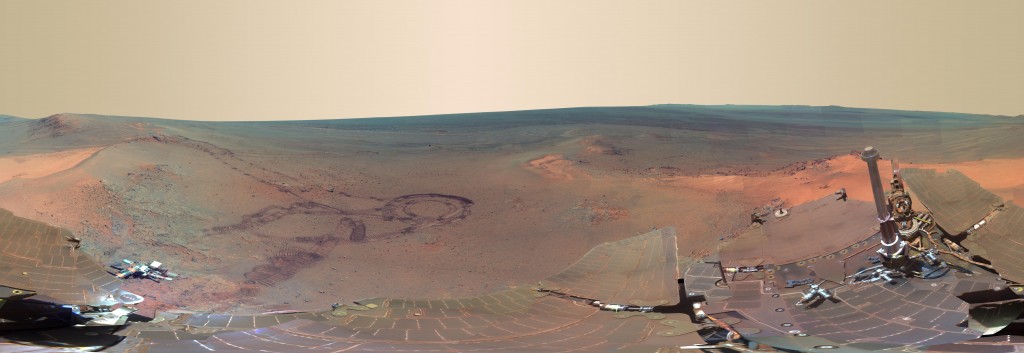
I commented on the landing of Curiosity on mars; here is a video that portrays the “7 minutes of terror” of the landing on Mars.
http://www.youtube.com/watch?v=Ki_Af_o9Q9s
On the day I will be at the NASA Deep Space Network at Tinbindilla, just outside of Canberra, in the Australian Capital Territory. There we will be live from NASA and receiving the first transmissions from Curiosity. Hopefully we will see scenes like these from the successful Phoenix landing at the Martian North Pole.
http://www.youtube.com/watch?v=hH5pNFROlYU&feature=relmfu